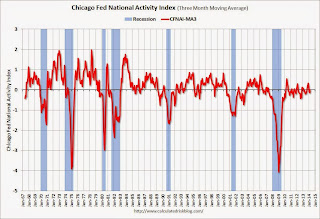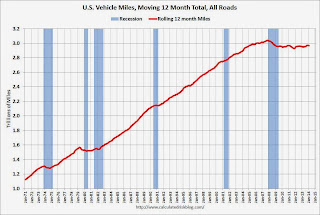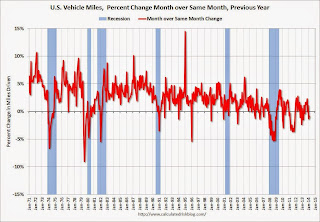by Calculated Risk on 4/22/2014 10:00:00 AM
Tuesday, April 22, 2014
Existing Home Sales in March: 4.59 million SAAR, Inventory up 3.1% Year-over-year
The NAR reports: Existing-Home Sales Remain Soft in March
Total existing-home sales, which are completed transactions that include single-family homes, townhomes, condominiums and co-ops, slipped 0.2 percent to a seasonally adjusted annual rate of 4.59 million in March from 4.60 million in February, and are 7.5 percent below the 4.96 million-unit pace in March 2013. Last month’s sales volume remained the slowest since July 2012, when it was 4.59 million.
Total housing inventory at the end of March rose 4.7 percent to 1.99 million existing homes available for sale, which represents a 5.2-month supply at the current sales pace, up from 5.0 months in February. Unsold inventory is 3.1 percent above a year ago, when there was a 4.7-month supply.
 Click on graph for larger image.
Click on graph for larger image.This graph shows existing home sales, on a Seasonally Adjusted Annual Rate (SAAR) basis since 1993.
Sales in March (4.59 million SAAR) were slightly lower than last month, and were 7.5% below the March 2013 rate.
The second graph shows nationwide inventory for existing homes.
 According to the NAR, inventory increased to 1.99 million in March from 1.90 million in February. Inventory is not seasonally adjusted, and inventory usually increases from the seasonal lows in December and January, and peaks in mid-to-late summer.
According to the NAR, inventory increased to 1.99 million in March from 1.90 million in February. Inventory is not seasonally adjusted, and inventory usually increases from the seasonal lows in December and January, and peaks in mid-to-late summer.The third graph shows the year-over-year (YoY) change in reported existing home inventory and months-of-supply. Since inventory is not seasonally adjusted, it really helps to look at the YoY change. Note: Months-of-supply is based on the seasonally adjusted sales and not seasonally adjusted inventory.
 Inventory increased 3.1% year-over-year in March compared to March 2013. This year-over-year increase in inventory suggests inventory bottomed early last year.
Inventory increased 3.1% year-over-year in March compared to March 2013. This year-over-year increase in inventory suggests inventory bottomed early last year.Months of supply was at 5.2 months in March.
This was slightly above expectations of sales of 4.56 million. For existing home sales, the key number is inventory - and the key story is inventory is still low, but up year-over-year. I'll have more later ...
Black Knight: Mortgage delinquency rate in March lowest since October 2007
by Calculated Risk on 4/22/2014 07:01:00 AM
According to Black Knight's First Look report for March, the percent of loans delinquent decreased in March compared to February, and declined by more than 16% year-over-year. This is the lowest level for mortgage delinquencies since October 2007.
Also the percent of loans in the foreclosure process declined further in March and were down 37% over the last year. Foreclosure inventory was at the lowest level since October 2008.
Black Knight reported the U.S. mortgage delinquency rate (loans 30 or more days past due, but not in foreclosure) decreased to 5.52% in March from 5.97% in February. The normal rate for delinquencies is around 4.5% to 5%.
The percent of loans in the foreclosure process declined to 2.13% in March from 2.22% in February.
The number of delinquent properties, but not in foreclosure, is down 538,000 properties year-over-year, and the number of properties in the foreclosure process is down 619,000 properties year-over-year.
Black Knight will release the complete mortgage monitor for March in early May.
| Black Knight: Percent Loans Delinquent and in Foreclosure Process | |||
|---|---|---|---|
| March 2014 | February 2014 | March 2013 | |
| Delinquent | 5.52% | 5.97% | 6.59% |
| In Foreclosure | 2.13% | 2.22% | 3.38% |
| Number of properties: | |||
| Number of properties that are 30 or more, and less than 90 days past due, but not in foreclosure: | 1,571,000 | 1,749,000 | 1,842,000 |
| Number of properties that are 90 or more days delinquent, but not in foreclosure: | 1,199,000 | 1,242,000 | 1,466,000 |
| Number of properties in foreclosure pre-sale inventory: | 1,070,000 | 1,115,000 | 1,689,000 |
| Total Properties | 3,840,000 | 4,106,000 | 4,997,000 |
Monday, April 21, 2014
Tuesday: Existing Home Sales, Richmond Fed Mfg Survey
by Calculated Risk on 4/21/2014 06:59:00 PM
Another builder reports below consensus results, from housing economist Tom Lawler: NVR: Net Orders Off Despite Jump in Community Count; Increased Mortgage Regulations Hit Mortgage Banking Income
NVR, Inc. the nation’s fourth largest home builder with a heavy concentration in the Mid-Atlantic region, reported that net home orders in the quarter ended March 31, 2014 totaled 3,325, down 5.3% from the comparable quarter of 2013. The company’s sales cancellation rate, expressed as a % of gross orders, was 12% last quarter, down from 13% a year ago. The company’s average community count last quarter was 481, up 10.6% from the comparable quarter of 2013. Home settlements totaled 2,211 last quarter, down 2.7% from the comparable quarter of 2013, at an average settlement price of $361,400, up 9.4% from a year ago. The company’s order backlog at the end of March was 6,059, down 2.5% from last March.Tuesday:
NVR’s operating income from its mortgage banking operation plunged by 91% from a year ago last quarter, with the decline attributed to a “more competitive” mortgage lending market, as well as higher G&A expenses “due to increased staffing in response to increased mortgage regulations and expected higher loan volume.”
NVR owned or controlled 65,800 lots at the end of March, up 10.2% from last March.
The company’s overall results last quarter were well below “consensus.”
• Early, the Black Knight "First Look" at Mortgage performance (delinquencies and foreclosures) in March.
• At 9:00 AM ET, the FHFA House Price Index for February 2013. This was original a GSE only repeat sales, however there is also an expanded index. The consensus is for a 0.3% increase.
• At 10:00 AM, the Existing Home Sales for March from the National Association of Realtors (NAR). The consensus is for sales of 4.56 million on seasonally adjusted annual rate (SAAR) basis. Sales in February were at a 4.60 million SAAR. Economist Tom Lawler estimates the NAR will report sales of 4.64 million SAAR.
• Also at 10:00 AM, the Richmond Fed Survey of Manufacturing Activity for April. The consensus is for a reading of 0, up from -7 in March.
Weekly Update: Housing Tracker Existing Home Inventory up 6.1% year-over-year on April 21st
by Calculated Risk on 4/21/2014 04:27:00 PM
Here is another weekly update on housing inventory ...
There is a clear seasonal pattern for inventory, with the low point for inventory in late December or early January, and then usually peaking in mid-to-late summer.
The Realtor (NAR) data is monthly and released with a lag (the most recent data was for February - March inventory data will be released tomorrow). However Ben at Housing Tracker (Department of Numbers) has provided me some weekly inventory data for the last several years.
 Click on graph for larger image.
Click on graph for larger image.
This graph shows the Housing Tracker reported weekly inventory for the 54 metro areas for 2010, 2011, 2012, 2013 and 2014.
In 2011 and 2012, inventory only increased slightly early in the year and then declined significantly through the end of each year.
In 2013 (Blue), inventory increased for most of the year before declining seasonally during the holidays. Inventory in 2013 finished up 2.7% YoY.
Inventory in 2014 (Red) is now 6.1% above the same week in 2013.
Inventory is still very low, but this increase in inventory should slow house price increases.
Note: One of the key questions for 2014 will be: How much will inventory increase? My guess is inventory will be up 10% to 15% year-over-year by the end of 2014 (inventory would still be below normal).
Chicago Fed: "Economic Growth Moderated in March"
by Calculated Risk on 4/21/2014 01:25:00 PM
The Chicago Fed released the national activity index (a composite index of other indicators): Economic Growth Moderated in March
Led by declines in production-related indicators, the Chicago Fed National Activity Index (CFNAI) decreased to +0.20 in March from +0.53 in February. Two of the four broad categories of indicators that make up the index made positive contributions to the index in March, and two of the four categories decreased from February. ...This graph shows the Chicago Fed National Activity Index (three month moving average) since 1967.
The index’s three-month moving average, CFNAI-MA3, increased to a neutral reading in March from –0.14 in February, marking its third consecutive nonpositive value. March’s CFNAI-MA3 suggests that growth in national economic activity was at its historical trend. The economic growth reflected in this level of the CFNAI-MA3 suggests limited inflationary pressure from economic activity over the coming year.
emphasis added
 Click on graph for larger image.
Click on graph for larger image.This suggests economic activity was at the historical trend in March (using the three-month average).
According to the Chicago Fed:
What is the National Activity Index? The index is a weighted average of 85 indicators of national economic activity drawn from four broad categories of data: 1) production and income; 2) employment, unemployment, and hours; 3) personal consumption and housing; and 4) sales, orders, and inventories.
A zero value for the index indicates that the national economy is expanding at its historical trend rate of growth; negative values indicate below-average growth; and positive values indicate above-average growth.
Report: Property Tax Collections above Pre-Recession Peak
by Calculated Risk on 4/21/2014 11:22:00 AM
From Bloomberg: Property-Tax Collections Rising at Fastest Pace Since U.S. Crash
Property-tax collections nationally rose to $182.8 billion during the last three months of 2013 ... according to a U.S. Census estimate last month. That topped the previous peak four years earlier ...
In cities including San Jose, California, Nashville, Tennessee, Houston and Washington, revenue from real-estate levies has set records, or is poised to.
Local governments are using the money to hire police, increase salaries and pave roads after the decline in property values and 18-month recession that ended in 2009 forced them to eliminate about 600,000 workers ...
 Click on graph for larger image.
Click on graph for larger image.Here is the report from the Census Bureau: Quarterly Summary of State and Local Government Tax Revenue for 2013:Q4
This graph from the Census Bureau report shows Q4 property taxes since 2003 - and property taxes have increased slightly in Q4 2013 and are back to the pre-recession peak.
This another data point suggesting that aggregate layoffs are over at the state and local level.
DOT: Vehicle Miles Driven decreased 0.8% year-over-year in February
by Calculated Risk on 4/21/2014 09:50:00 AM
Some of this monthly decline appears weather related since miles driven were down 3.0% in the Northeast. Miles driven were up 0.4% in the West.
The Department of Transportation (DOT) reported:
Travel on all roads and streets changed by -0.8% (-1.7 billion vehicle miles) for February 2014 as compared with February 2013.The following graph shows the rolling 12 month total vehicle miles driven.
...
Travel for the month is estimated to be 212.8 billion vehicle miles.
The rolling 12 month total is still mostly moving sideways but has started to increase a little recently.
 Click on graph for larger image.
Click on graph for larger image.In the early '80s, miles driven (rolling 12 months) stayed below the previous peak for 39 months.
Currently miles driven has been below the previous peak for 75 months - 6+ years - and still counting. Currently miles driven (rolling 12 months) are about 2.3% below the previous peak.
The second graph shows the year-over-year change from the same month in the previous year.
 In February 2014, gasoline averaged of $3.43 per gallon according to the EIA. that was down from February 2013 when prices averaged $3.73 per gallon.
In February 2014, gasoline averaged of $3.43 per gallon according to the EIA. that was down from February 2013 when prices averaged $3.73 per gallon.As we've discussed, gasoline prices are just part of the story. The lack of growth in miles driven over the last 6 years is probably also due to the lingering effects of the great recession (high unemployment rate and lack of wage growth), the aging of the overall population (over 55 drivers drive fewer miles) and changing driving habits of young drivers.
With all these factors, it might take a few more years before we see a new peak in miles driven.
Sunday, April 20, 2014
Sunday Night Futures
by Calculated Risk on 4/20/2014 08:39:00 PM
An article from Tim Logan at the LA Times on a subject I've discussed with several people via email: Student debt holds back many would-be home buyers
Of the many factors holding back young home buyers — rising prices, tougher lending standards, a still-shaky job market — none looms larger than the recent explosion of college debt.Monday:
The amount owed on student loans has tripled in a decade, to nearly $1.1 trillion, according to the Federal Reserve Bank of New York. People in their 20s and 30s — often the best-educated and highest-earning among them — owe most of that tab. That is keeping a crucial segment of home buyers on the sidelines, deferring one of the traditional markers of adult success.
• At 8:30 AM ET, the Chicago Fed National Activity Index for March. This is a composite index of other data.
Weekend:
• Schedule for Week of April 20th
From CNBC: Pre-Market Data and Bloomberg futures: the S&P futures are up 3 and DOW futures are up 35 (fair value).
Oil prices are up recently with WTI futures at $104.25 per barrel and Brent at $109.53 per barrel.
Below is a graph from Gasbuddy.com for nationwide gasoline prices. Nationally prices are around $3.63 per gallon (up sharply over the last ten weeks and more than 10 cents above the level of a year ago). If you click on "show crude oil prices", the graph displays oil prices for WTI, not Brent; gasoline prices in most of the U.S. are impacted more by Brent prices.
| Orange County Historical Gas Price Charts Provided by GasBuddy.com |
WSJ: Slight Easing of Mortgage Credit Standards
by Calculated Risk on 4/20/2014 10:51:00 AM
From Nick Timiraos and AnnaMaria Andriotis at the WSJ: Mortgage Lenders Ease Rules for Home Buyers in Hunt for Business
While standards remain tight by historical measures, lenders have started to accept lower credit scores and to reduce down-payment requirements.No one wants a return to the loose lending standards of the mid-00s - and I hope we never see another Alt-A loan - but I expect standards to loosen over the next few years.
...
Another sign that banks could get less picky: Credit scores for borrowers seeking conventional mortgages also are easing. Scores on purchase mortgages stood at 755 in March, down from 761 a year earlier, according to data from Ellie Mae, a mortgage-software provider. Those on purchase loans backed by the FHA dropped to 684, compared with 696 one year earlier. ...
Smaller lenders are accepting even lower scores. Average credit scores on purchase loans closed through a consortium called LendingTree fell to 679 in March, down from the year-earlier 715.
...
"Tiny fractions of borrowers can do things that they could not a year ago," said Lou Barnes, a mortgage banker in Boulder, Colo.
Saturday, April 19, 2014
Unofficial Problem Bank list declines to 521 Institutions
by Calculated Risk on 4/19/2014 01:25:00 PM
This is an unofficial list of Problem Banks compiled only from public sources.
Here is the unofficial problem bank list for April 18, 2014.
Changes and comments from surferdude808:
An expected update from the OCC on its recent enforcement action activity contributed to a noticeable reduction in the Unofficial Problem Bank List this week. After nine removals, the list stands at 521 institutions with assets of $168.9 billion. A year ago, the list held 781 institutions with assets of $288.5 billion.
Finding their way off the list through merger were National Bank of Earlville, Earlville, IL ($57 million) and Liberty Savings Bank, F.S.B., Pottsville, PA ($23 million). Actions were terminated against Eastern Savings Bank, FSB, Hunt Valley, MD ($425 million); Phoenixville Federal Bank and Trust, Phoenixville, PA ($388 million); First Federal Savings Bank, Ottawa, IL ($380 million); Southwestern National Bank, Houston, TX ($348 million); Columbia Community Bank, Hillsboro, OR ($335 million Ticker: CLBC); Pacific Global Bank, Chicago, IL ($155 million); The First National Bank of Hartford, Hartford, AL ($120 million); and Central Federal Savings and Loan Association of Chicago, Chicago, IL ($95 million).
Next Friday we anticipate an update from the FDIC on its recent enforcement action activity.


